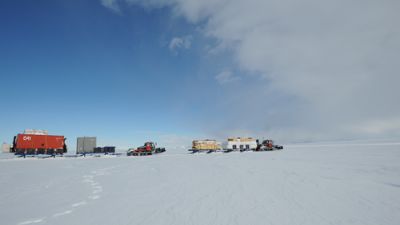
Live from Antarctica: Destination Crown Bay
Today's contribution comes from our guest writer Lt Col. Rene Wagemans, head of the Army contingent of the BELARE expedition. Having taken part in most of the traverses, he explains what it is like to do the journey from Utsteinen to Crown Bay and back.
Two days ago, we left for the coast with another convoy of three tractors to drop off eight empty containers and load eight other ones filled with construction material. As the construction is slightly ahead of the planned timing, there is a certain pressure on us to get the job done. After this traverse, there will only be one left to do and our team will have accomplished the contract in bringing all containers back to the construction site.
In general, we leave at 0815hr, after a last check on the sledges. It is always a long journey to Crown Bay, it takes us about 16 hours to get there at an average speed of 15km/hr. Leaving from an altitude of 1300m, we end up at approximately 30m above sea level. Our way over is therefore much faster than our way back. Given that our sledges are not so heavily loaded, we take the opportunity to improve the track by using the snow shovel. This is a delicate job, requiring you to be attentive in order to avoid digging yourself in whilst driving!
During the first five hours of our trip, there are still some "mountains" around us but once we have passed the Romnøs (60 km from Utsteinen) and entered "the plain", the landscape becomes white as far as you can see. Only the Prinoth tracks left by previous convoys betray some human presence. On our way, we mostly have to face the katabatic winds that shuffle over the huge plains, whipping up snow, and sometimes decrease severely our visibility.
Sometimes we are forced to only drive with the GPS. For a couple of days now, we have become the privileged spectators of the first sunsets and sunrises in the Antarctic. Each one is a beautiful sight with fabulous colours of which even a picture could never meet the eye view.
In general, we arrive at Crown Bay around midnight. In good weather, you can see the container park some 6 km away which means there is still about 20 minutes left to drive. Once we have arrived, we split up in different teams: two teams are responsible for the unloading and loading of the containers and one team is responsible for preparing the site for the sledges with the Hammar (hydraulic container crane) sledge in order to get the job done. The third team is also responsible for marking the containers to be loaded, for loading the gasoline drums and for preparing our only hot meal during the traverse. It now takes us no more than 4 hours for the convoy to be assembled and ready for departure. But first, we will have our hot meal.
Now is the time to make some jokes and to boost ourselves up, as fatigue is slowly but surely taking hold of us. The first part of the way back is, for most of us, a permanent struggle to not fall asleep. A real nightmare! Once we have reached our first refuelling point, we change seats with our colleagues. Generally, it goes a little bit better then but, sometimes, we also have a tendency to stop for a nap. For those who have accumulated enough sleep, there is a place in our ten foot living container (mounted on one of the sledges) to get some sleep. However, the noise and movement of the sledge has hindered most of us from falling in the arms of Morpheus...it helps anyway, though.
Fortunately for us, we have only registered a couple of technical problems. In general, our military mechanics can solve the problem(s) immediately. On one occasion, we were forced to leave a tractor behind which had broken down some 75km away from the base camp on our way back. A team of two mechanics went back the next morning to see whether or not the failure could be repaired on-site. Unfortunately, the verdict was without appeal: central spindled shaft from the final drive damaged. They had to dig in a sledge to mount the tractor with one track still working on it before they towed everything back to the base camp. As we had no spare parts available, it had to be ordered and arrived some ten days later with a flight scheduled by the Japanese Expedition in the Sør Rondane Mountains.
Once we have passed the Romnøs, we know that the end is near but that the most difficult part for our machines is still to come. With three fully loaded sledges and a climb from 500 to 1300m in altitude, we have to watch our instruments to make sure that our tractors are not overheating. Finally, from our last refuelling point, we only have a two hour drive left on a more or less flat land before we reach a hot meal and some well deserved sleep (at -16°C in our tents).
Picture: Prinoth tractors during a traverse - © International Polar Foundation
